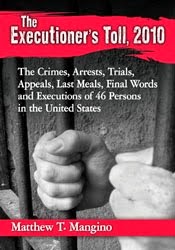A push to repeal the death penalty in Utah, once a bedrock
of conservative support for capital punishment, has garnered unlikely
bipartisan support, writes David Dudley for The Crime Report.
Utah Rep. Lowry Snow, a Republican, voted twice against bids
to repeal the death penalty in Utah in the past. Now, he’s the chief sponsor
of HB
147, which seeks to prohibit the state from seeking the death penalty for
aggravated murder committed after May 4, 2022.
Instead, the current draft of the bill includes a possible
sentence of 45 years-to-life for aggravated murder.
He’s partnered with Sharon Wright Weeks, who started as a
forceful advocate of the death penalty after her sister was killed—but has
since shifted position.
Their combined efforts could result in a repeal during this
year’s Utah legislative session, which runs Jan. 18 to March 4, 2022.
With support from two groups who are often in opposition to
one another, the American Civil Liberties Union and the Libertas Institute, as
well as a growing number of state and municipal officials, Weeks and Snow said
they feel like they’ve got a fighting chance.
And they’re not alone.
Losing Faith in the Justice System
Weeks’ 24-year-old sister, Brenda Lafferty, and her
15-month-old niece, Erica, were brutally murdered in American Fork, Utah in
1984.
The men who killed them, Ron and Dan Lafferty, were the
brothers of Brenda’s husband, Allen. The Laffertys were members of a fundamentalist
sect of the Church of Jesus Christ of Latter-day Saints.
Ron Lafferty said he received a message from God, ordering
him to kill the woman and her daughter, along with three others.
Weeks told The Crime Report that she relived the
pain of those horrific events throughout the trial that followed.
“But I felt a sense of relief when Dan Lafferty received two
consecutive life sentences, and Ron Lafferty was sentenced to death,” she said.
In 1991, Ron Lafferty’s verdict was overturned by the 10th
Circuit Court of Appeals in Denver. That was the beginning of a 30-year battle
to see justice served, as Lafferty appealed numerous times, claiming that he
wasn’t competent to stand trial.
Weeks said that she’s felt shackled to “them” ― the term she
uses to refer to the Lafferty brothers ― while waiting for Ron Lafferty to be
executed by the State of Utah.
“Every time he appealed, the media dragged out the details
of my sister’s murder,” Weeks said. “And every time that happens, I have to
live through the murders, and my family’s pain, again.”
Weeks said that she felt no sense of justice after Lafferty
died in prison of natural causes in 2019.
“I don’t think the state does it on purpose,” she said. “Utah’s
system is broken. And it needs to be replaced with something that works.”
‘That’s God’s Work’
Rep. Snow told The Crime Report that he met with
Weeks in 2017. He didn’t know who she was.
“But as she told me her story, I was moved,” Snow said. “I’d
never thought about that side of the story.”
As Snow looked into how many people were on death row in
Utah, and the number of years that they’d spent there waiting to be executed,
he said he realized that something had gone awry.
“I became even more suspicious when I learned that there
were an increasing number of inmates on death row who were being exonerated,”
he said.
“That’s when my thinking on the subject began to change. The
promise of justice is made in good faith, but it was clearly failing in some
cases.”
Snow said that, at the time, 18 people had been exonerated
in Utah, including one for murder.
The idea that someone could sit on death row for an
indefinite amount of time, and that some were executed despite being innocent,
were deeply troubling to Snow.
“In some cases, we ask juries to impose the death sentence
upon people,” he said.
“But sometimes there’s insufficient evidence. Sometimes
there’s misconduct on the behalf of prosecutors or police.”
That a citizen can be deprived of the highest right society
bestows upon its citizenry, the right of life, in such uncertain circumstances,
Snow said, is unacceptable.
“Whether in the womb or in the world, I’m pro-life,” he
said. “I don’t think we have the right to decide another person’s life in such
imperfect circumstances. That’s God’s work. Only God gets to do that.”
Utah Fits the Profile
Robert Dunham, the executive director of the Washington
D.C.-based Death Penalty Information Center, said that Utah fits the profile of
a traditionally conservative state that may be ripe for a change.
Dunham cited a Gallup
Poll released in November, which showed a decline in nationwide
support for the death penalty.
“It also showed that the number of conservatives who no
longer support capital punishment is increasing,” Dunham told The Crime
Report.
“The poll shows that 27 percent of conservatives are now
against capital punishment, a significant shift in support.”
One of the reasons for the shift, Dunham said, is that
Americans are relatively uninformed about the death penalty.
“The more they learn,” he said, “the more they are against
it. And this can inform policy decisions in various ways.”
The death penalty may not make sense fiscally, Dunham said,
because “statistically speaking, inmates like Ron Lafferty are more likely to
die while on death row than to be executed.”
According to a 2017
study done by Torin McFarland, each death penalty inmate costs
approximately “$1.12 million (2015 USD) more than a general population inmate.”
There are seven men on death row in Utah right now.
Collectively, they’ve served more than 200 years, costing tax-payers millions.
That number increases exponentially “as appeals processes drag on, and the
state pays costs associated with trial, prosecution and incarceration,” Dunham
said.
The death penalty may not be a deterrent to violent crime.
“Murder rates hold steady in states that have the death penalty,” Dunham said.
“Those states that have abolished the death penalty did not
see increases in the murder rate. If the death penalty was a deterrent, we
would see those rates trend upward, and above the national average.”
The homicide rate in states with the death penalty has been
48 percent to 101 percent higher than in states without the death penalty,
according to this study,
which compares data from the FBI’s Uniform Crime Reports.
Weeks’ experience is common amongst victims’ families, Dunham
said.
“Weeks has been shackled to Ron Lafferty for 35 years,”
Dunham said, “as he went through two trials and a number of appeals.”
By the time it reached the appellate, the trial was no
longer about the murder, it was about Lafferty’s mental state.
“That can feel very demeaning to victims’ families,” Dunham
said. “They’re reliving these crimes. They’re hanging on to anger, which fuels
a need for vengeance. So, it’s bad for our emotional health as these cases drag
on for years and decades.”
“I can’t say it will happen,” Dunham concluded, “but Utah
definitely fits the profile of conservative states that have turned the corner
on the death penalty.”
Who’s on Board?
Republican Sen. Dan McCay will sponsor the bill in the Utah
Senate, where in 2016 a bid to repeal the death penalty (SB
189) was approved by a vote of 15-13. It ultimately failed in the House
that year.
Abolishing the death penalty is gaining momentum in communities
around Utah. At least four other county attorneys have publicly endorsed Snow’s
bill.
Utah County Attorney David Leavitt announced in September
that he will no longer seek the death penalty, according to a
report by The Salt Lake Tribune, because the “costs far outweigh its
benefits to the community as a whole.”
Likewise, Utah County Commissioners voted 2-1 in October to
pass a resolution urging state lawmakers to do away with the death penalty.
Another Utah Senator, Republican Don Ipson, said that, while
he believes the death penalty as it stands is broken, he doesn’t want to “take
tools out of the prosecutor’s toolbox.”
So, he will vote against the bill when it reaches the senate
floor.
“We can’t continue to keep people on death row for 30-plus
years, while they go through endless rounds of appeals,” said Ipson, who was
Chair of the Utah House Committee of Law Enforcement and Criminal Justice in
2016, when the last bid to repeal the death penalty stalled in the House.
Though he opposes the bill in favor of revising the death
penalty, Ipson expects Snow to be well prepared.
“And it would be wise for everyone to listen to him before
casting their vote,” Ipson said.
To read more CLICK HERE







